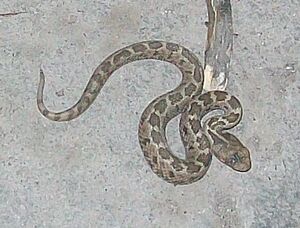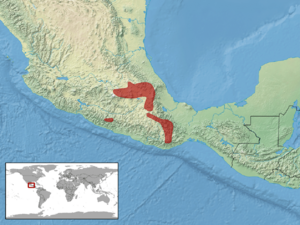Mexican pigmy rattlesnake facts for kids
Quick facts for kids Mexican pigmy rattlesnake |
|
|---|---|
 |
|
| Conservation status | |
| Scientific classification | |
| Genus: |
Crotalus
|
| Species: |
ravus
|
 |
|
| Synonyms | |
|
|
The Crotalus ravus, also known as the Mexican pygmy rattlesnake, is a type of venomous pit viper. This snake is found only in Mexico. There are three different types, called subspecies, that scientists currently recognize.
Contents
About the Mexican Pygmy Rattlesnake
This section explains how scientists classify the Mexican pygmy rattlesnake. It also describes the different types of this snake.
How Scientists Classify This Snake
Scientists study snake DNA to understand how different snakes are related. Studies show that the Mexican pygmy rattlesnake is closely related to other rattlesnakes. These include Crotalus triseriatus, Crotalus pusillus, Crotalus aquilus, and Crotalus lepidus. These studies also found clear genetic differences between the three subspecies. This helps scientists understand their family tree.
Types of Mexican Pygmy Rattlesnakes
There are three recognized subspecies of the Mexican pygmy rattlesnake. Each one lives in a specific area of Mexico.
| Subspecies | Named By | Common Name | Where It Lives |
|---|---|---|---|
| C. r. brunneus | Harris & Simmons, 1977 | Oaxacan pygmy rattlesnake | Mexico in the highlands of Oaxaca. |
| C. r. exiguus | Campbell & Armstrong, 1979 | Guerreran pygmy rattlesnake | Mexico in the Sierra Madre del Sur of central Guerrero. |
| C. r. ravus | (Cope, 1865) | Central Mexican pygmy rattlesnake | Mexico in the Altiplanicie Meridional. This includes the states of México, Morelos, Tlaxcala, Puebla, and Veracruz. |
Physical Description
Mexican pygmy rattlesnakes are usually about 40–65 centimetres (16–26 in) long. Some can grow even longer, reaching over 70 cm (28 in). They have a moderately thick body.
The most common type, C. r. ravus, has some special features. Its head scales, called parietal scales, can look very different. It also has fewer than 3 prefoveal scales and 21 dorsal scales around its middle. This snake usually has 2 to 4 bands on its tail and a fairly large rattle.
Where They Live
These snakes are found only in the mountains of central and southern Mexico. They live west of the Isthmus of Tehuantepec. Their home range includes parts of the Mexican Plateau. This covers the highlands of Mexico, Morelos, Tlaxcala, Puebla, Veracruz, and Oaxaca. They also live in the Sierra Madre del Sur in Guerrero.
Scientists describe these snakes as living in temperate areas. They prefer moderate to high elevations on the Mexican Plateau. They can be found from about 1,490 metres (4,890 ft) up to a little over 3,000 m (9,800 ft) above sea level.
Conservation Status
The Mexican pygmy rattlesnake is listed as "Least Concern" by the IUCN. This means it is not currently at high risk of extinction globally. However, the Mexican government listed it as "threatened" in 2010. This shows that local efforts are important to protect this unique snake.


